About Ahmedabad
“Recently, Ahmedabad has been declared as India’s First World Heritage City by UNESCO”.
Nestled in the heart of the Gujarat, Ahmedabad is a zesty city that provides a generous buffet of stimulations that swears to enliven all the five senses. Recently, Ahmedabad has been declared as India’s First World Heritage City by UNESCO. Located on the banks of river Sabarmati, with an area of 92.98 Sq. Kms, and a population of 5.5 millions, the city is an amalgamation of culture, history, tradition and modernity with modern malls and multiplexes on one side and museums and monuments of historical importance on the other side of the river. Besides being home to a number of important industries, Ahmedabad is one of the rising centres of higher education, information technology and scientific industries in western India. With an exciting combination of traditions and modernism, Ahmedabad captures all visitors with its diversity of places, religious and ethnic communities.
Ahmedabad is well connected by road, rail and air with various national and international cities on the globe. The weather of Ahmedabad is very pleasant during the month of January with the temperature ranging between 20-25 degrees Celsius. Still carrying light woolen clothes is suggested.
The city offers to celebrate year round festivals that include Ras Garba, Dipawali, Kite festival and many more. Many places of tourist interest – Science city, Akshardham, Adalaj vav (Step well), etc are situated in and around the city.
Dwarka

Dwarka also spelled as Dvarika, Dwaraka, and Dvaraka, is a city and under Jamnagar district in the Gujarat state in India. Dwarka is one of the seven most ancient cities in the country. The present temple was built from 6th to 7th century, while the original temple was believed to have been built by Krishna’s great grandson, King Vajra. The 5-storied temple is made of limestone and sand. A flag is hoisted in the temple tower five times each day. There are two gateways – Swarga Dwar, where pilgrims enter, and Moksha Dwar, where pilgrims exit. From the temple one can view the Sangam (confluence) of River Gomati flowing towards the sea. In Dwaraka, there are also shrines for Vasudeva, Devaki, Balarama and Revati, Subhadra, Rukmini Devi, Jambavati Devi and Satyabhama Devi. There is a special temple for Rukmini Devi on the way to the Bet Dwarka temple. Bet Dwarka, a similar deity to Lord Dwarakanath, is also kept in Bet Dwaraka. The temple of Bet Dwarka can be reached by boat. The temple has many shrines for Lakshmi Narayana, Trivikrama, Jambavati Devi, Satyabhama Devi and Rukmini Devi.
Somnath

The Somnath Temple is located in the Prabhas Kshetra near Veraval in Saurashtra, on the western coast of Gujarat, India, and is one of the twelve Jyotirlinga shrines of the God Shiva. Somnath means “The Protector of (the) Moon God”. The Somnath Temple is known as “the Shrine Eternal”, having been destroyed many times by various kings and rulers. Most recently it was rebuilt in November 1947, when Sardar Vallabhbhai Patel visited the area for the integration of Junagadh and mooted a plan for restoration. After Patel’s death, the rebuilding continued under K. M. Munshi, another minister of the Government of India. In 725 CE Junayad, the Arab governor of Sind sent his armies to destroy the second temple. The Gurjara Pratihara king Nagabhata II constructed the third temple in 815, a large structure of red sandstone. Later on a joint effort of Peshwa of Pune, Raja Bhonsle of Nagpur, Chhatrapati Bhonsle of Kolhapur, Queen Ahilyabai Holkar of Indore & Shrimant Patilbuwa Shinde of Gwalior rebuilt the temple in 1783 at a site adjacent to the ruined temple.
Ambaji

Ambaji mata temple is a major Shakti Peeth of India. It is situated at a distance of approximately 65 kilometres from Palanpur, 45 kilometres from Mount Abu and 20 kilometres from Abu Road, 42 Kilometer from Shri Amirgadh, 50 kilometer from Kadiyadra near the Gujarat and Rajasthan border. Just 5km away from Ambaji Temple, The famous mountain of Gabbar is situated on the border of States of Gujarat and Rajasthan, near the flow of the origin of the famous Vedic virgin river SARASWATI, on the hills of Arasur in forest, towards south-west side to ancient hills of Arvalli, at the altitude of about 480 meters, at about 1600 feet high from sea level, having at 8.33 km2 (5 sq. miles area ) area as a whole, and it is in fact One of the Fifty One (51) famous Ancient Pauranik Shakti Piths. The Centre of Cosmic Power of India and it is the original holy place of Mata Ambaji, where the piece of the heart of the dead body of Devi Sati fell at the top of this holy hill of Gabbar as per the legend narrated in the “Tantra Chudamani”.
Sun Temple, Modhera

The Sun Temple, at Modhera in Gujarat, is a temple dedicated to the Hindu Sun-God, Surya. It was built in 1026 AD by King Bhimdev of the Solanki dynasty. This temple depicts the essence of ancient times. The sculptures and architecture present in this temple are still magnificent after all these years. In the present times, prayers are not offered in this temple. The Sun Temple was built by Rushabh Bhimdev I of Solanki Dynasty in AD 1026. This was the time when Somnath and the adjoining area was plundered by Mahmud Ghazni and reeled under the effects of his invasion. The Solankis, however, regained much of their lost power and splendour. Anahilvad Patan, the Solanki capital, was restored to glory. Royalty and traders jointly contributed to build grand temples. Solankis were considered to be Suryavanshi, Gurjar or descendants of Sun god. The temple was so designed that the first rays of the sun fell on the image of Surya, the Sun God, at the time equinoxes. The temple is partially in ruins after it was also finally destroyed by the Allauddin Khilji.
Lothal

Lothal is situated near the village of Saragwala in the Dholka Taluka of Ahmedabad district. It is six kilometres (south-east) of the Lothal-Bhurkhi railway station on the Ahmedabad-Bhavnagar railway line. Discovered in 1954, Lothal was excavated from 13 February 1955 to 19 May 1960 by the Archaeological Survey of India (ASI). Lothal’s dock-the world’s earliest known, connected the city to an ancient course of the Sabarmati river on the trade route between Harappan cities in Sindh and the peninsula of Saurashtra when the surrounding Kutch desert of today was a part of the Arabian Sea. Lothal was a small village next to the river providing access to the mainland from the Gulf of Khambhat. Ceramic wares were of fine clay and smooth, micaceous red surface. A new technique of firing pottery under partly oxidizing and reducing conditions was improved by them—designated black-and-red ware, to the micaceous Red Ware. Harappans were attracted to Lothal for its sheltered harbour, rich cotton and rice-growing environment and bead-making industry. The beads and gems of Lothal were in great demand in the west. The settlers lived peacefully with the Red Ware people, who adopted their lifestyle, evidenced from the flourishing trade and changing working techniques. Harappans began producing the indigenous ceramic goods, adopting the manner from the natives.
Ahmedpur-Mandvi Beach
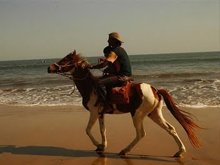
Ahmedpur Mandvi Beach is situated on the coastline of the state of Gujarat, India. It is located in Ahmedpur Mandvi, near Diu (Union Territory of Daman and Diu) in Junagadh District. It is one of the 14 beaches chosen by the state to promote beach tourism.
Tithal Beach

Tithal Beach is a beach along the Arabian Sea located 4 km west of Valsad town in Indian state of Gujarat. This beach is famous for its black sand. It is a popular tourist destination in south Gujarat. Apart from the beach, places of interest at Tithal including two major temples- the Shri Sai Baba temple located 1.5 km south of the main beach and Shri Swami Narayan temple located 1.6 km north of the main beach. Both the temples overlook the Arabian Sea. The main beach has several shops selling Indian snacks like Bhajiya, Dabeli, Bhel chaat, sweet corn roasted on charcoal and also freshly prepared sugar cane juice, coconut water and souvenirs.
Saputara
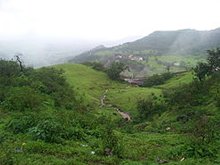
Saputara is a city and a hill station municipality in the Dang district of Gujarat state in India. This picturesque hill station is perched on a plateau in the Dang forest area of the Sahyadri range at an altitude of about 1000 m. The highest temperature even in the summer does not exceed 28 °C. Saputara means the ‘Abode of Serpents’ and a snake image on the banks of the river Sarpagana is worshiped by the Adivasis on Holi. Saputara has been developed as a planned hill resort with all the necessary amenities like hotels, parks, swimming pools, boat club, theaters, ropeways and a museum to ensure an enjoyable holiday in the cool of the hill. Saputara is only 172 km. from Surat and 250 km from Mumbai. Saputara will soon have its own airport as state government is considering the plan. Maharashtra state border is only 4 km away from Saputara. Excursions from Saputara can be made to the wild life sanctuary in the Mahal Bardiparaforest, 60 km. from here and to Gira Waterfalls 52 km away.
Girnar
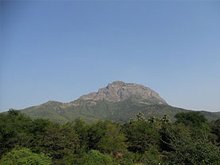
Girnar (also known as Girnar Hill or Girinagar) is a collection of mountains in the Junagadh District of Gujarat, India, situated near Junagadh at a distance of 327 km from Ahmedabad. In fact, Girnar has been a sacred place well before the Dholavira and Mohan-jo-daro period and its origin can be traced back to the Vedas and other holy scriptures of various Indus Valley based religions. Older than Himalayas, Girnar, the mountain and its range are considered sacred and it’s an important pilgrimage site for both Hindus and Jains, who gather here during the Girnar Parikrama festival. Significantly famous among Shiva devotees for the mystic space-time of the mountain range with known presence and turnover of different sects of Sadhu Babas, Nath sect, different Jain Tirthankaras to Girnar, its typical flora and fauna, the famous Maha Shivratri fair, Girnar hosts a number of temples and some historical spots across its range. Amidst the lush green Gir Forest, the mountain range serves as the hub of religious activity.
Gir Forest National Park

The Gir Forest National Park and Wildlife Sanctuary (also known as Sasan-Gir) is a forest and wildlife sanctuary in Gujarat, India. Established in 1965, with a total area of 1412 km² (about 258 km² for the fully protected area (the national park) and 1153 km² for the Sanctuary), the park is located 65 km to the south-east of Junagadh and 60 km to south west of Amreli. It is the sole home of the Asiatic Lions (Panthera leo persica) and is considered to be one of the most important protected areas in Asia due to its supported species. The ecosystem of Gir, with its diverse flora and fauna, is protected as a result of the efforts of the government forest department, wildlife activists and NGOs. The forest area of Gir and its lions were declared as “protected” in the early 1900s by the Nawab of the princely state of Junagadh. This initiative assisted in the conservation of the lions whose population had plummeted to only 15 through slaughter for trophy hunting. The April 2010 census recorded the lion-count in Gir at 411, an increase of 52 compared to 2005. The lion breeding programme covering the park and surrounding area has bred about 180 lions in captivity since its inception.
Porbandar
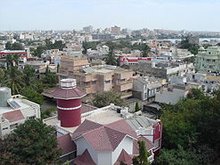
Porbandar is a coastal city in the Indian state of Gujarat, perhaps best known for being the birthplace of Mahatma Gandhi and Sudama (friend of Lord Krishna). It is the administrative center of Porbandar District.
Rann of Kutch
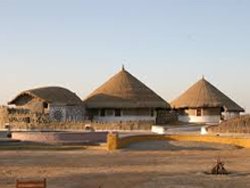
The Great Rann of Kutch, is a seasonal salt marsh located in the Thar Desert in the Kutch District of Gujarat, India and the Sindh province of Pakistan. It is about 7,505.22 square kilometres (2,897.78 sq mi) in size and is reputed to be the largest salt desert in the world. This area has been inhabited by the Kutchi people.
Experience The Kutch at its colourful and exotic best during the Rann Utsav in Every December, Kutch, Gujarat, India. This annually organized festival offers an opportunity for visitors to attend Folk Dance, desert festival kutch, desert festival gujarat, desert festival india, Camel Safari, Live-in -Tents, Musical Moments, Visit the Centuries and many more activities.